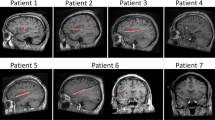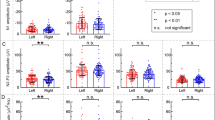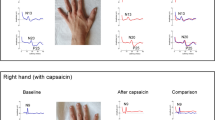Abstract
THE discovery of opiate-like peptides (endorphins) in brain, blood and cerebrospinal fluid1–4 raises questions as to the physiological role of these substances. Given the prominent analgesic effects of opiates, the regulation of pain perception is a candidate for endorphin action. Endorphins microinjected into the periacqueductal grey matter of rats induce analgesia which is reversed by naloxone, a pure narcotic antagonist5. If endorphins play an active part in the regulation of pain, then naloxone administered to man should alter pain appreciation. Naloxone has not been shown to have analgesic, respiratory, euphoric, pupillary or electroencephalogram (EEG) effects in man6. Studies in rats7,8 and one early study in man9 have suggested slight hyperalgesic effects with naloxone. El-Sobky et al.10 failed to demonstrate naloxone effects on electric shock pain judgments in five subjects. In the experiments reported here, subjects were divided into pain sensitive and pain insensitive subgroups. The insensitive subjects found shocks significantly more painful after naloxone administration while the sensitive group experienced them as less painful. Evoked potentials showed similar significant group differences. These results suggest that individual differences in pain sensitivity may relate to differences in an endorphin system.
This is a preview of subscription content, access via your institution
Access options
Subscribe to this journal
Receive 51 print issues and online access
$199.00 per year
only $3.90 per issue
Buy this article
- Purchase on Springer Link
- Instant access to full article PDF
Prices may be subject to local taxes which are calculated during checkout
Similar content being viewed by others
References
Hughes, J. Brain Res. 88, 259–308 (1975).
Terenius, L. & Wahlstrom, A. Life Sci. 16, 1759–1764 (1975).
Frederickson, R., Schirmer, E. W., Grinnan, E. L., Harrell, C. W. & Hewes, C. R. Life Sci. 19, 1181–1184 (1976).
Pert, C. B., Pert, A. & Tallman, J. F. Proc. natn. Acad. Sci. U.S.A. 73, 2226–2230 (1976).
Pert, A. in Opiates and Endogenous Opioid Peptides 87–94 (Elsevier, North Holland, New York, 1976).
Jasinski, D. R., Martin, W. R. & Haertzen, C. A. J. Pharmac. exp. Ther. 157, 420–426 (1967).
Jacob, J. J., Tremblay, E. C. & Colombel, M. C. Psychopharmacologia (Berl.) 37, 217–223 (1974).
Frederickson, R. C. A., Nickander, R., Smithwick, E. C., Shuman, R. & Norris, F. H. in Opiates and Endogenous Opioid Peptides 239–246 (Elsevier North Holland, New York, 1976).
Lasagna, L. Proc. R. Soc. Med. 58, 978–983 (1965).
El-Sobky, A., Dostrovsky, J. D. & Wall, P. D. Nature 263, 783–784 (1976).
Tursky, B. Psychophysiology 11, 95–112 (1974).
Sitaram, N., Buchsbaum, M. S. & Gillin, J. C. Eur. J. Pharm. 42, 285–290 (1977).
Lavine, R., Buchsbaum, M. S. & Poncy, M. Psychophysiology 13, 140–148 (1976).
Chapman, C. R., Murphy, T. M. & Butler, S. H. Science 179, 1246–1248 (1972).
Clark, W. C. & Goodman, J. S. J. Abnormal Psych. 83, 364–372 (1974).
Buchsbaum, M. S. in Biology of the Major Psychoses: A comparative Analysis 129–142 (Raven, New York, 1975).
Leybin, L., Pinsky, C., Labella, F. S., Havelicek, V. & Rezek, M. Nature 264, 458–459 (1976).
Author information
Authors and Affiliations
Rights and permissions
About this article
Cite this article
BUCHSBAUM, M., DAVIS, G. & BUNNEY, W. Naloxone alters pain perception and somatosensory evoked potentials in normal subjects. Nature 270, 620–622 (1977). https://doi.org/10.1038/270620a0
Received:
Accepted:
Issue Date:
DOI: https://doi.org/10.1038/270620a0
This article is cited by
-
Human abuse liability assessment of oxycodone combined with ultra-low-dose naltrexone
Psychopharmacology (2010)
-
Anger Expression and Pain: An Overview of Findings and Possible Mechanisms
Journal of Behavioral Medicine (2006)
-
Self-injur, pain, and the endorphin theory
Journal of Developmental and Physical Disabilities (1994)
-
Emotional numbing: A possible endorphin-mediated phenomenon associated with post-traumatic stress disorders and other allied psychopathologic states
Journal of Traumatic Stress (1992)
-
Effect of auricular electrical stimulation and naloxone on nociceptive sensitivity in rabbits
Bulletin of Experimental Biology and Medicine (1990)
Comments
By submitting a comment you agree to abide by our Terms and Community Guidelines. If you find something abusive or that does not comply with our terms or guidelines please flag it as inappropriate.



